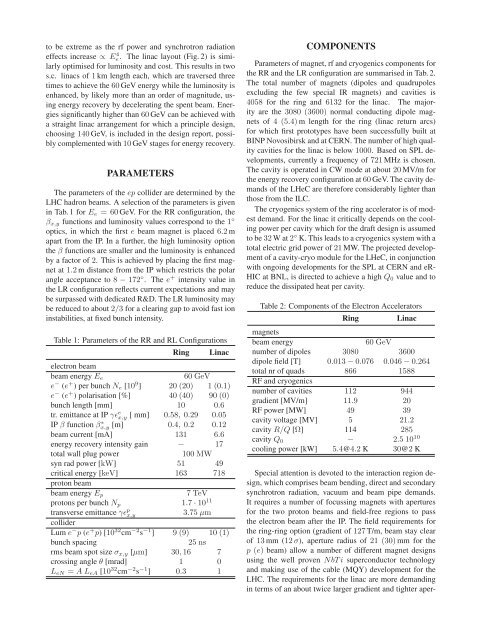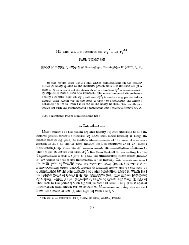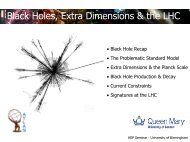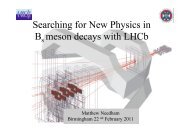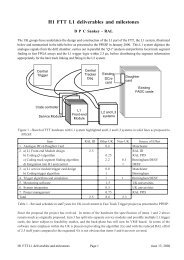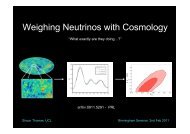design concepts for the large hadron electron collider
design concepts for the large hadron electron collider
design concepts for the large hadron electron collider
- No tags were found...
Create successful ePaper yourself
Turn your PDF publications into a flip-book with our unique Google optimized e-Paper software.
to be extreme as <strong>the</strong> rf power and synchrotron radiationeffects increase ∝ E 4 e . The linac layout (Fig. 2) is similarlyoptimised <strong>for</strong> luminosity and cost. This results in twos.c. linacs of 1 km length each, which are traversed threetimes to achieve <strong>the</strong> 60 GeV energy while <strong>the</strong> luminosity isenhanced, by likely more than an order of magnitude, usingenergy recovery by decelerating <strong>the</strong> spent beam. Energiessignificantly higher than 60 GeV can be achieved witha straight linac arrangement <strong>for</strong> which a principle <strong>design</strong>,choosing 140 GeV, is included in <strong>the</strong> <strong>design</strong> report, possiblycomplemented with 10 GeV stages <strong>for</strong> energy recovery.PARAMETERSThe parameters of <strong>the</strong> ep <strong>collider</strong> are determined by <strong>the</strong>LHC <strong>hadron</strong> beams. A selection of <strong>the</strong> parameters is givenin Tab. 1 <strong>for</strong> E e =60GeV. For <strong>the</strong> RR configuration, <strong>the</strong>β x,y functions and luminosity values correspond to <strong>the</strong> 1 ◦optics, in which <strong>the</strong> first e beam magnet is placed 6.2 mapart from <strong>the</strong> IP. In a fur<strong>the</strong>r, <strong>the</strong> high luminosity option<strong>the</strong> β functions are smaller and <strong>the</strong> luminosity is enhancedby a factor of 2. This is achieved by placing <strong>the</strong> first magnetat 1.2 m distance from <strong>the</strong> IP which restricts <strong>the</strong> polarangle acceptance to 8 − 172 ◦ . The e + intensity value in<strong>the</strong> LR configuration reflects current expectations and maybe surpassed with dedicated R&D. The LR luminosity maybe reduced to about 2/3 <strong>for</strong> a clearing gap to avoid fast ioninstabilities, at fixed bunch intensity.Table 1: Parameters of <strong>the</strong> RR and RL ConfigurationsRing Linac<strong>electron</strong> beambeam energy E e60 GeVe − (e + ) per bunch N e [10 9 ] 20 (20) 1 (0.1)e − (e + ) polarisation [%] 40 (40) 90 (0)bunch length [mm] 10 0.6tr. emittance at IP γɛ e x,y [ mm] 0.58, 0.29 0.05IP β function βx,y ∗ [m] 0.4, 0.2 0.12beam current [mA] 131 6.6energy recovery intensity gain − 17total wall plug power100 MWsyn rad power [kW] 51 49critical energy [keV] 163 718proton beambeam energy E p7TeVprotons per bunch N p 1.7 · 10 11transverse emittance γɛ p x,y3.75 μm<strong>collider</strong>Lum e − p (e + p)[10 32 cm −2 s −1 ] 9 (9) 10 (1)bunch spacing25 nsrms beam spot size σ x,y [μm] 30, 16 7crossing angle θ [mrad] 1 0L eN = AL eA [10 32 cm −2 s −1 ] 0.3 1COMPONENTSParameters of magnet, rf and cryogenics components <strong>for</strong><strong>the</strong> RR and <strong>the</strong> LR configuration are summarised in Tab. 2.The total number of magnets (dipoles and quadrupolesexcluding <strong>the</strong> few special IR magnets) and cavities is4058 <strong>for</strong> <strong>the</strong> ring and 6132 <strong>for</strong> <strong>the</strong> linac. The majorityare <strong>the</strong> 3080 (3600) normal conducting dipole magnetsof 4(5.4) m length <strong>for</strong> <strong>the</strong> ring (linac return arcs)<strong>for</strong> which first prototypes have been successfully built atBINP Novosibirsk and at CERN. The number of high qualitycavities <strong>for</strong> <strong>the</strong> linac is below 1000. Based on SPL developments,currently a frequency of 721 MHz is chosen.The cavity is operated in CW mode at about 20 MV/m <strong>for</strong><strong>the</strong> energy recovery configuration at 60 GeV. The cavity demandsof <strong>the</strong> LHeC are <strong>the</strong>re<strong>for</strong>e considerably lighter thanthose from <strong>the</strong> ILC.The cryogenics system of <strong>the</strong> ring accelerator is of modestdemand. For <strong>the</strong> linac it critically depends on <strong>the</strong> coolingpower per cavity which <strong>for</strong> <strong>the</strong> draft <strong>design</strong> is assumedto be 32 Wat2 ◦ K. This leads to a cryogenics system with atotal electric grid power of 21 MW. The projected developmentof a cavity-cryo module <strong>for</strong> <strong>the</strong> LHeC, in conjunctionwith ongoing developments <strong>for</strong> <strong>the</strong> SPL at CERN and eR-HIC at BNL, is directed to achieve a high Q 0 value and toreduce <strong>the</strong> dissipated heat per cavity.Table 2: Components of <strong>the</strong> Electron AcceleratorsRing Linacmagnetsbeam energy60 GeVnumber of dipoles 3080 3600dipole field [T] 0.013 − 0.076 0.046 − 0.264total nr of quads 866 1588RF and cryogenicsnumber of cavities 112 944gradient [MV/m] 11.9 20RF power [MW] 49 39cavity voltage [MV] 5 21.2cavity R/Q [Ω] 114 285cavity Q 0 − 2.5 10 10cooling power [kW] 5.4@4.2 K 30@2 KSpecial attention is devoted to <strong>the</strong> interaction region <strong>design</strong>,which comprises beam bending, direct and secondarysynchrotron radiation, vacuum and beam pipe demands.It requires a number of focussing magnets with apertures<strong>for</strong> <strong>the</strong> two proton beams and field-free regions to pass<strong>the</strong> <strong>electron</strong> beam after <strong>the</strong> IP. The field requirements <strong>for</strong><strong>the</strong> ring-ring option (gradient of 127 T/m, beam stay clearof 13 mm (12 σ), aperture radius of 21 (30) mm <strong>for</strong> <strong>the</strong>p (e) beam) allow a number of different magnet <strong>design</strong>susing <strong>the</strong> well proven NbTi superconductor technologyand making use of <strong>the</strong> cable (MQY) development <strong>for</strong> <strong>the</strong>LHC. The requirements <strong>for</strong> <strong>the</strong> linac are more demandingin terms of an about twice <strong>large</strong>r gradient and tighter aper-


